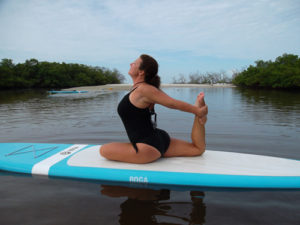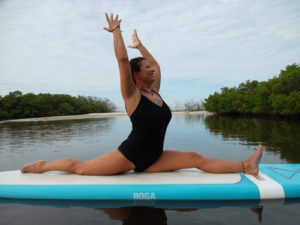More than the Core with Paddleboard Yoga
By Nancy B. Loughlin
Published in News Press on August 14, 2012. Posted with permission.
For paddleboard yoga teacher Marcie Gillis, the first yoga pose makes a splash. She’ll lead the class into the waters off Lovers Key, tell them to assume Vrksasana (Tree Pose, otherwise known as balancing on one leg) and then watch them all unceremoniously tumble into the surf.
“Success!” Gillis will undoubtedly cheer.
There isn’t much patience for asmita, the ego, when moving through a paddleboard yoga practice. But, Gillis argued, that’s the point. It’s time to harness the will, the fire in the belly, and try something new.
The word is out that there isn’t a better core workout than paddleboarding. Beneath Fort Myers Beach Bridge, the paddleboard converts dot the waves like water nymphs, precariously standing on planks slightly wider than surfboards and paddling them with long oars.
But, adding yoga to the board transforms the calm ripples just south of Dog Beach into tsunamis. Yoga on a mat can offer a full workout with muscular and cardio benefits, but yoga really isn’t about the body. It’s about energy and spirit. For Gillis, those subtler yoga benefits are amplified on the board.
Gillis, owner of SWFL Standup, explained that paddleboard yoga demands a mindfulness that doesn’t always show up in a studio. On the floor, a student can move from Warrior One to Warrior Two while contemplating the post-yoga shopping list (naughty). But, once the mind wanders in a paddleboard practice, the board is going to nudge the student back to the present immediately, sometimes with a wobble, ultimately with a splash.
Being present is not optional on the board. It’s a necessity.
“The board is telling you just as much, if not more, than the teacher in this class,” she said.
Gillis suggested that achieving the coveted yogic state of mindfulness is actually easier out in nature, surrounded by mangroves, the bird calls, and lapping water.
“It’s hard to come out here and bring all your troubles. It feels like you’re walking a lot farther than from your car,” she said.
The word yoga actually means “to yoke,” or, more simply, a state of union. Gillis’ students can often experience this unity more profoundly on the water. She described how the breath will become synchronized with the rhythms of the water, and the rocking of waves will settle the body deeper into the poses.
“You can feel as though you are one with all the rhythms of the universe,” she said.
Savasana is the final pose in all yoga practices. Savasana, also known as Corpse Pose, is a final meditation to rejuvenate the body after the contortions, cleansing, and re-alignment of a vinyasa flow. While paddleboard yoga students are cradled in this deep relaxation, Gillis plays the crystal bowl aligned with the third chakra, the solar plexus.
The third chakra is about empowerment and the will to act and achieve, fitting since the core is the target muscle group in paddleboarding. Gillis strikes the bowl with a wand and runs the padded tip around the edge, like a fingertip to a wineglass rim. The note of “E” rings through the trees and over the silent meditating students, their fingers dipping into the water’s surface.
Like Gillis said, it’s the fire in the belly to try something new.
Resources:


